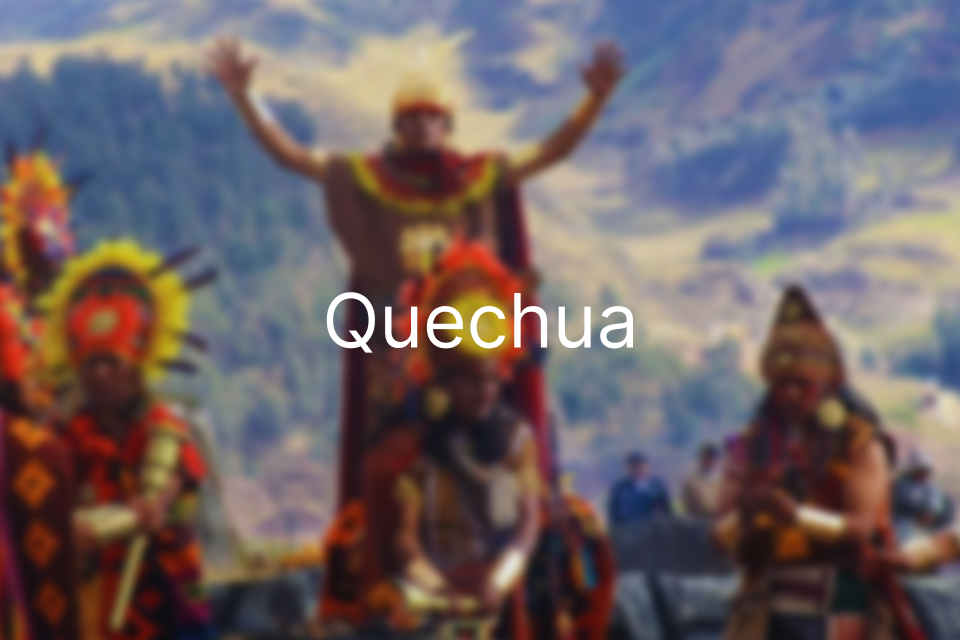Quechua Language: A Living Legacy of the Andes

TABLE OF CONTENTS

This detailed survey note explores the Quechua language, providing a comprehensive overview for English-speaking readers interested in its linguistic, historical, and cultural dimensions. The content is structured to align with the user’s request for a blog post, ensuring accessibility, credibility, and cultural sensitivity, with a length of approximately 1,200–1,500 words.
Introduction: The Voice of the Andes
Often called “Runasimi” (the people’s language), Quechua is a vibrant testament to the history and resilience of the indigenous cultures of the Andes. Once the official language of the sprawling Inca Empire, which flourished from 1438 to 1533, it remains a vital pillar of modern Andean identity. With an estimated 7 to 10 million speakers, Quechua is the most widely spoken pre-Columbian language family in the Americas.
This article provides a comprehensive overview of Quechua for English-speaking readers. We will explore its current status, trace its historical journey, and outline practical ways to begin learning it. By the end, you will have the foundational knowledge to appreciate and engage with this remarkable linguistic heritage. You will learn about its speakers and dialects, its journey from the Inca Empire to modern revitalization, the benefits of learning it, and the essential first steps—from pronunciation to useful phrases—to start your journey.
Language Overview: Demographics and Dialects

Quechua is not a single language but a family of related languages and dialects spoken across the Andean highlands. Precise, up-to-date speaker counts are challenging to obtain due to infrequent census data and varying methodologies across countries, but recent estimates from 2020-2023 place the number of speakers around 7 million.
The language is primarily spoken in Peru, Bolivia, Ecuador, and to a lesser extent in Colombia, Argentina, and Chile.
| Country | Estimated Speakers | Official Status & Notes |
|---|---|---|
| Peru | ~3.8 million | Co-official with Spanish since 1975. Highest number of speakers. |
| Bolivia | ~2.1 million | Co-official nationwide since 2009. |
| Ecuador | ~1 million+ | Known as Kichwa; holds official status in designated regions. |
| Argentina | ~50,000–100,000 | Primarily in northwestern provinces like Jujuy and Salta. |
| Colombia | ~5,000–15,000 | Spoken by small communities in the south, known as Inga Kichwa. |
| Chile | Minimal | Mostly spoken by Bolivian and Peruvian immigrants. |
To understand its diversity, it helps to think of Quechua like the Romance languages. Just as Spanish and Italian are related but not always mutually intelligible, the major Quechua dialect groups—such as Southern Quechua (spoken in Cusco and Bolivia) and Kichwa (spoken in Ecuador)—have significant differences in pronunciation and vocabulary.
Historical Background: From Inca Lingua Franca to Modern Revival

Contrary to popular belief, Quechua predates the Incas, with origins tracing back to central Peru around 2,600 BCE. The Inca Empire adopted it as their administrative language, which accelerated its spread across the Andes. During the Spanish conquest in the 16th century, Catholic priests often used Quechua as a lingua franca to evangelize, which ironically helped it survive and spread further. However, following indigenous uprisings in the late 18th century, Spanish authorities suppressed its use.
In the 20th and 21st centuries, Quechua has seen a resurgence. It gained official status in Peru, Bolivia, and Ecuador, and bilingual education programs are now in place. Despite challenges like a lack of written materials and social stigma, cultural initiatives—from contemporary music and films to blogs and poetry—are driving its revitalization and helping to preserve its rich heritage for future generations.
Why Learn Quechua? Connecting with Culture, Travel, and Academia
Learning Quechua offers a unique window into the Andean worldview, connecting you with centuries of history, tradition, and culture.
- Cultural Immersion: It provides a deeper understanding of Andean cosmovision, social values, and artistic expression.
- Enhanced Travel: In rural areas of Peru, Bolivia, and Ecuador, speaking even a few phrases of Quechua can open doors, foster genuine connections, and transform your travel experience.
- Academic and Professional Opportunities: Knowledge of Quechua is a valuable asset in fields like anthropology, archaeology, linguistics, and international development. It is highly sought after for research and for work with NGOs focused on cultural preservation and community support in the region.
Writing System & Alphabet: From Knotted Cords to Latin Script
Traditional Andean textiles showcase the intricate patterns that, like quipu, conveyed complex information
Before the arrival of the Spanish, Quechua was an oral language. The Incas used a complex system of knotted strings called quipu for record-keeping and data transmission. While a sophisticated information system, the quipu is not a writing system in the phonetic sense, as the knots and colors encoded numerical and categorical data, not the sounds of speech.
Today, Quechua uses the Latin alphabet. A standardized orthography was introduced in Peru in 1975, though variations exist across different dialect regions. The alphabet contains familiar letters but also distinct sounds. For English speakers, the three-vowel system (a, i, u) is straightforward, while consonants like ll (like the ‘lli’ in million) and ñ (like the ‘ny’ in canyon) will be familiar to those with some Spanish knowledge.
Pronunciation Guide: Mastering the Basic Sounds
Quechua pronunciation is quite regular. Here are a few key points:
- Vowels: The three core vowels are a, i, u. The sounds are “pure” and short, like the vowels in the Spanish words padre, *mi, and tú.
- Stress: The stress almost always falls on the penultimate (second-to-last) syllable. For example, allillanchu (hello) is pronounced ah-yee-YAHN-choo.
- Key Consonants:
- ll: A soft “ly” sound (e.g., llama).
- ñ: A “ny” sound (e.g., ñaña - sister).
- q: A deep, guttural sound made in the back of the throat, similar to an Arabic ‘qaf’. It has no English equivalent.
- Ejectives and Aspirates: Some dialects feature ejective consonants (like p’, t’, k’), which are produced with a sharp burst of air. These can be challenging for beginners but are not present in all varieties.
Examples:
- Yaku (Water) - YAH-koo
- Inti (Sun) - EEN-tee
- Urqu (Mountain) - OOR-koo
Learning Resources: Your Path to Fluency

A wealth of resources is available for learning Quechua:
- University Courses: Institutions like Ohio State University, the University of Pennsylvania, and Indiana University offer formal Quechua programs.
- Digital Tools: Apps like Memrise have user-created Quechua courses. Online dictionaries and translator tools like the OpenL Quechua Translator are useful for beginners.
- Audio Resources: For pronunciation practice, consider using Forvo pronunciation dictionary and various YouTube channels that offer audio lessons and cultural content.
- Online Communities & Media: Search for Quechua learning groups on Facebook or Reddit. Podcasts like Rimasun provide excellent listening practice.
- Immersion: The most effective method is to travel to a Quechua-speaking region for a homestay or language program.
Getting Started: Essential Phrases

Begin your journey with these fundamental phrases from Southern Quechua:
- Hello: Allillanchu? (ah-yee-YAHN-choo?)
- I’m well, and you?: Allillanmi, qanri? (ah-yee-YAHN-mee, kahn-ree?)
- Thank you: Sulpayki (sool-PIE-kee)
- Yes: Arí (ah-REE)
- No: Mana (MAH-nah)
- What is your name?: Imataq sutiyki? (ee-mah-TAQ soo-TEE-kee?)
- My name is…: Sutiymi… (soo-TEEM-ee…)
Set realistic goals, like learning five new words a day or practicing greetings with audio clips. Consistent, small steps will pave the way to meaningful progress.
Conclusion: A Living Bridge to the Past
Quechua is more than just a language; it is a living bridge to one of the world’s great ancient civilizations and a vibrant expression of contemporary Andean life. Whether you are motivated by travel, academic interest, or a desire to support cultural preservation, learning Quechua is an enriching and deeply rewarding endeavor. With the resources outlined here, you are well-equipped to take the first step on this fascinating linguistic and cultural adventure.
References
- Quechuan languages overview and speaker estimates
- Quechua cultural and historical context
- Benefits of learning Quechua for academics
- Quechua writing and alphabet details
- Quechua pronunciation dictionary for learners
- Resources for learning Quechua online
- Basic Quechua glossary for beginners
- Quechua language podcasts and audio resources
- Useful Quechua phrases for travel
- Practical Quechua phrases for visiting Cusco
- Quechua translation tool for beginners
- Quechua phonetic guide and examples
- Quechua phonetics and pronunciation videos
- Quechua educational resources at universities
- Historical survival of Quechua language
- Quechua as a living cultural tradition
- Quechua language courses and research
- Introduction to Quechua for travelers
- Quechua in the context of Inca Empire
- Quechua dialect variations and learning tips
- Quechua language and cultural immersion


